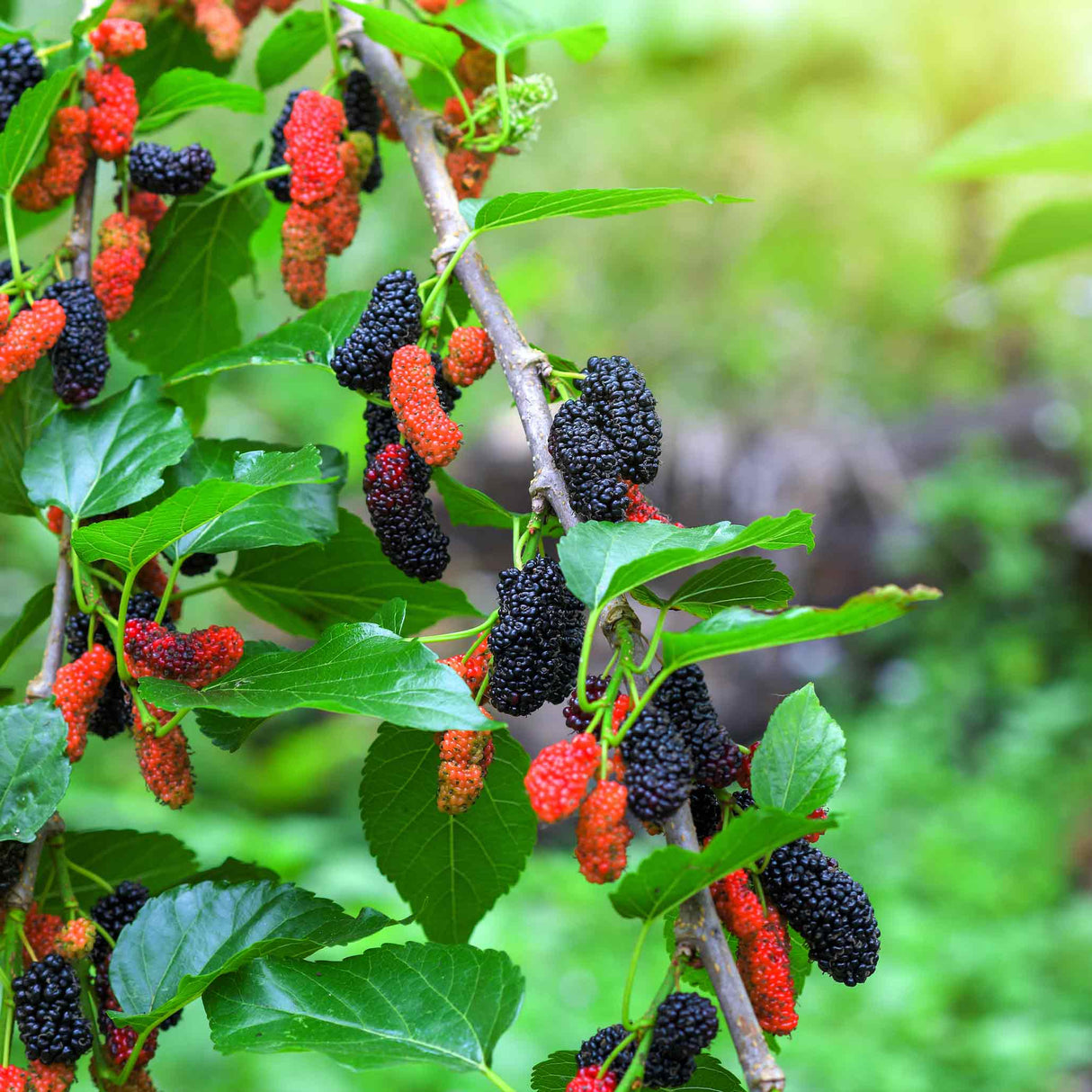Everbearing Mulberry Tree
Plant Health Guaranteed
Your Plants are Guaranteed
Your Plants are Guaranteed
Your plants are guaranteed to arrive happy & healthy with our 30 Day Plant Promise. Your order will arrive healthy and stay healthy while they adapt to your climate. If not, just call us at (704) 443-8256.
Free Shipping on All Orders
Free Shipping on All Orders
Free shipping on all orders. Your plants will ship out the next business day... expertly packed so that your plants will arrive happy and healthy!
Planting & Care
Planting & Care
|
The Everbearing Mulberry Tree thrives in Zones 4-10 
If you live in the green area above, we recommend the Everbearing Mulberry Tree. |
||
| Your Growing Zone | ||
| Recommended Zones | 4-10 | |
| Mature Height | 15 ft. | |
| Mature Width | 6-8 ft. | |
| Cannot Ship To | AZ, OR | |
| Sunlight | Full to Partial Sun | |
| Botanical Name | Morus alba 'Everbearing' | |
|
The Everbearing Mulberry Tree thrives in Zones 4-10 
If you live in the green area above, we recommend the Everbearing Mulberry Tree. |
|
| Your Growing Zone | |
| Recommended Zones | 4-10 |
| Mature Height | 15 ft. |
| Mature Width | 6-8 ft. |
| Cannot Ship To | AZ, OR |
| Sunlight | Full to Partial Sun |
| Botanical Name | Morus alba 'Everbearing' |
Description
Description
Everbearing Mulberry Tree – A Hardy, Fast-Growing Tree with Delicious, Nutrient-Rich Fruit
The Everbearing Mulberry Tree (Morus alba 'Everbearing') is a highly productive and fast-growing fruit tree that provides a bountiful harvest of sweet, juicy mulberries throughout the summer. Known for its long fruiting season and low-maintenance care, this hardy tree is perfect for home gardeners looking for a reliable, nutritious fruit source. In addition to producing delicious berries, the Everbearing Mulberry Tree also provides shade with its large, lush green leaves, making it a practical and attractive addition to any landscape.
Key Features of the Everbearing Mulberry Tree:
- Long Fruit Harvest: Produces sweet, juicy, black mulberries continuously from early summer through late summer or even early fall.
- Fast-Growing & Productive: Grows quickly, reaching heights of 10-15 feet, with abundant fruit yields that get better year after year.
- Easy to Grow & Maintain: Thrives in USDA Zones 4-10, tolerating a wide range of climates and soil conditions with minimal care.
- High in Nutrients: Mulberries are rich in vitamins, antioxidants, and fiber, making them a healthy, delicious snack or ingredient for jams, smoothies, and desserts.
- Attractive Shade Tree: Its broad canopy of large green leaves makes it a perfect shade tree for backyards, patios, or garden areas.
A Bountiful Harvest of Sweet, Juicy Mulberries
The Everbearing Mulberry Tree is famous for its long fruiting season, providing a steady supply of mulberries from early summer through late summer. These plump, black mulberries are bursting with sweet, tangy flavor and are perfect for fresh eating, making pies, jams, smoothies, or even drying for later use. With its continuous production of berries, this tree ensures you’ll have plenty of fresh fruit to enjoy all summer long.
Fast-Growing & Perfect for Small Yards
This variety of mulberry is fast-growing, reaching a manageable height of 10-15 feet, making it ideal for smaller yards or urban spaces. Its compact size allows it to fit easily into a variety of garden settings, while still providing an impressive yield of fruit. The tree’s naturally spreading canopy offers plenty of shade, making it a practical choice for homeowners looking for both beauty and function in their landscape.
Easy to Grow & Low Maintenance
The Everbearing Mulberry Tree is incredibly easy to care for, making it perfect for both novice and experienced gardeners. It thrives in full sun but can also tolerate partial shade, and it adapts well to a variety of soil types, including clay, loam, and sandy soils. Once established, it’s drought-tolerant and requires little water, making it a great choice for low-maintenance gardening. This hardy tree is resistant to pests and diseases, ensuring years of reliable fruit production with minimal care.
Nutrient-Rich and Versatile Fruit
Mulberries are not only delicious, but they’re also packed with nutrients. They’re rich in vitamins C and K, as well as antioxidants and dietary fiber, making them a healthy snack that supports immune health, digestion, and overall wellness. The fruit can be enjoyed fresh or used in a wide variety of recipes, including jams, pies, wines, and even smoothies. With the Everbearing Mulberry Tree, you’ll have a steady supply of nutrient-rich fruit for your family to enjoy.
Ideal for a Wide Range of Climates
The Everbearing Mulberry Tree is highly adaptable to different climates, thriving in USDA Zones 4-10. Whether you live in a cold northern region or a warm southern area, this tree will perform beautifully. Its hardiness allows it to tolerate both hot summers and cold winters, making it an excellent choice for gardeners in diverse growing regions. The tree grows quickly, reaching maturity within just a few years and rewarding you with fruit and shade early in its life.
Why Choose Nationwide Plants?
At Nationwide Plants, we’re committed to offering the highest quality trees and shrubs for your garden. Our Everbearing Mulberry Trees are hand-selected for their health and productivity, ensuring that they arrive at your home ready to thrive. With fast, reliable shipping and exceptional customer service, we make it easy to bring this productive and low-maintenance tree to your landscape.
Start Growing Delicious, Healthy Mulberries – Order Your Everbearing Mulberry Tree Today!
Enjoy sweet, nutrient-packed mulberries all summer long with the easy-to-grow Everbearing Mulberry Tree. Perfect for small yards, patios, or larger orchards, this fast-growing, low-maintenance tree will reward you with abundant fruit and shade year after year. Order today from Nationwide Plants and enjoy fast delivery of this productive tree right to your door!



